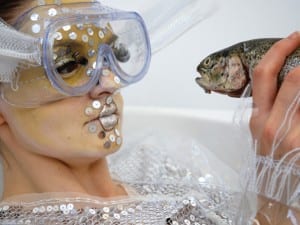The paraphernalia of the movie saturates the contemporary world. Since the Lumière brothers and George Méliès, artists have appropriated its affects and revealed its fictions. Yet in Edgar Schmitz’ exhibition Surplus Cameo Decor it is not the visual rituals of film that are called into question, it is more tellingly the function of those who perform within and by their presence endorse and activate, the movie’s remotely exotic locales.Devised as an imaginary film in three episodes; Palasthotel, Horizontes Soroa and Sindano, Surplus Cameo Decor is a changing “set” of two way mirrors, swimming pool covers and plastic membranes, composed for a sequence of “cameo” appearances. Described as “international celebrities” in the exhibition’s publicity the cameo’s include Ulli Lommel who collaborated with Rainer Werner Fassbinder before becoming a director of cult horror movies; Tobias Berger, the curator of M+, a supermuseum opening in Hong Kong in 2017; Lisa LeFeuvre, Head of Sculpture Studies at the Henry Moore Institute, Leeds and Wang Nanming, a writer and curator from Shanghai. Situated amongst props and discursive “elsewheres”, their cameo appearances, in the flesh and via live video feed, provide a critical point of access to the supra-local narrative of exhibition making.
Contemporary art spaces, like the Cooper Gallery in Dundee, the BALTIC Centre for Contemporary Art in Gateshead or indeed the future “super” museum M+, operate as a stage from where the cultural consumer can witness a ceaseless flow of aestheticized capital, which like the invited art professionals, makes temporary landings in “cultural hubs” around the globe. By inviting Lommel, Nanming and the rest, Schmitz activates them as discursive objects, which authenticate the fictions that lend authoritative force to a cultural hub. For Surplus Cameo Decor, the material traces deployed to evoke a projected and remote elsewhere, such as the two-way mirror, become backdrops for the legitimizing agency of a performed body.
First used to describe a precious stone in the 13th century, cameo attained its current usage in the sense of a “small character that stands out from other minor parts” via a usage as a “short literary sketch or portrait”. Surplus Cameo Decor compresses the threefold meanings of cameo into an apt description of the status of Lommel, Wang et al within the global art economy. This meaning was echoed in the publication, on the same day as the exhibition opening, of Art Review’s list of the 100 most important figures in contemporary art. Although not on this list, Schmitz’ cameos are part of this index of value and here in lies their discursive function. The cameo, as precious object and portrait defines Wang, Berger etc as assets that displaces an encounter with an art object, in favour of the figure of the art professional whose presence and participation provides legitimacy for an exhibition and a cultural hub. Disregarding the rhetoric of public engagement and participatory art, exhibition making and a cultural hub are performed situations. Governed by a consistently reproduced script, in which value and visibility is produced by the necessities of cultural capital, this performativity locates the audience, technician, critic, artist or curator as extras. Whether standing centre stage, in the wings or in the cheap seats, all the participants in this drama are mobilized equally.
The critical aspect of contemporary arts practice lies not in the props that decorate or illuminate an exhibition space, but in the purposeful staging of “participants” in the “performance” of exhibition making and the critical cogency of Edgar Schmitz’ Surplus Cameo Decor lies in its oblique revealing of some of the bit part players in this drama of exhibition.
Edgar Schmitz’ Surplus Cameo Decor, 18 October 2012 – 14 December 2012, Cooper Gallery, DJCAD, Dundee
John Dummett
Credits
All images courtesy of Edgar Schmitz and Cooper Gallery





